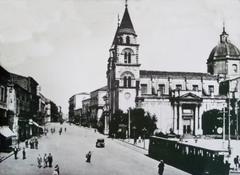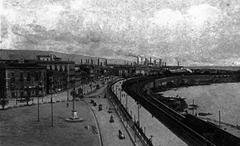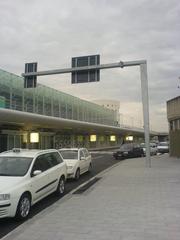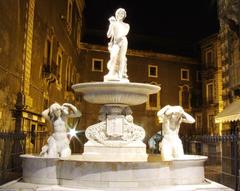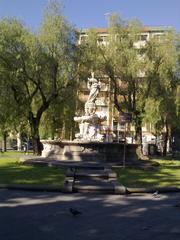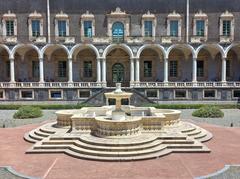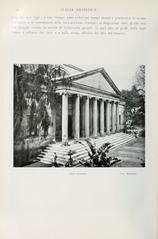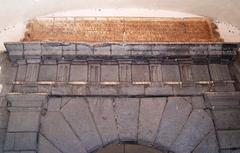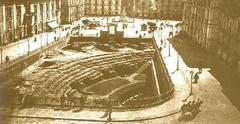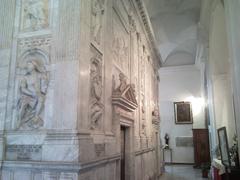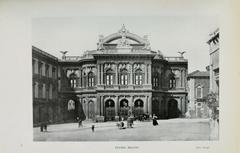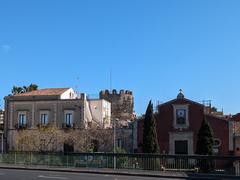
Pozzo di Gammazita Visiting Hours, Tickets, and Catania Historical Sites Guide
Date: 04/07/2025
Introduction
The Pozzo di Gammazita, nestled in the historic heart of Catania, Sicily, is more than just an ancient well—it is a living testament to the city’s layered history, enduring legends, and vibrant civic identity. Dating back to the 12th century, this medieval structure invites visitors to journey into Catania’s past, where myth and reality intertwine. The well is famously associated with the legend of Gammazita, a young woman who chose to defend her honor at the cost of her life, a story that became a symbol of resistance during the Sicilian Vespers and continues to inspire local culture and memory. This comprehensive guide offers essential information about Pozzo di Gammazita visiting hours, ticketing, accessibility, and nearby historical attractions, ensuring you make the most of your visit to one of Catania’s most evocative sites (Pozzo di Gammazita in Catania: Visiting Hours, Tickets, and Historical Significance; Sicilian Post; Gammazita.it).
Table of Contents
- Introduction
- Medieval Origins and Waterways of Catania
- The Legend of Gammazita: Story and Symbolism
- Artistic and Literary Depictions
- The Well as a Site of Memory
- Visiting Pozzo di Gammazita: Hours, Tickets, and Accessibility
- How to Reach Pozzo di Gammazita
- Practical Visitor Tips
- Nearby Attractions
- Contemporary Cultural Initiatives
- Preservation and Future Prospects
- FAQ
- Visuals and Media
- Conclusion
- Contact and Further Information
Medieval Origins and Waterways of Catania
Pozzo di Gammazita is located in a courtyard near Via San Calogero, adjacent to the ancient city walls known as “cortina di Gamma Zita” (Wikipedia). The well, built in the 12th century from local lava stone and Sicilian terracotta, once played a crucial role in the daily life of the city and its Jewish quarter. It was fed by the subterranean Amenano River and accessed by a staircase of 62 steps. The well’s base is now sealed by a mass of lava, a reminder of Catania’s volcanic environment and the devastating 1669 eruption that buried much of the area.
The Legend of Gammazita: Story and Symbolism
Origins and Narrative
The well is inextricably linked to the legend of Gammazita, a story rooted in the late 13th century during the Angevin (French) occupation of Sicily. According to tradition, Gammazita was a virtuous young woman from Catania, engaged to be married. On her wedding day, while drawing water from the well, she was accosted by a French soldier. Rather than submit to his advances, she leapt into the well, choosing death over dishonor (Sicilian Post; Etna Experience; Siciliafan). In some versions, other characters, such as the jealous Macalda Scaletta, add intrigue to the tale.
Symbolic Significance
Gammazita’s sacrifice has become a symbol of female virtue and resistance. Her story is seen as a metaphor for Sicilian resilience and the refusal to submit to foreign domination, especially during the Sicilian Vespers uprising of 1282 (Sicilian Post). Locals point to iron-red stains on the well’s walls as the lasting mark of her blood, reinforcing the story’s emotional resonance (Enjoy Sicilia). The legend is preserved in proverbs, poetry, and annual festivals, serving as an enduring expression of Catania’s character.
Artistic and Literary Depictions
Gammazita’s legend has inspired generations of artists and writers. In Catania’s Piazza Università, one of the four bronze candelabra, created by Mimì Maria Lazzaro, immortalizes her story (Sicilian Magpie). The tale is also woven into plays, poems, and local folklore, ensuring its ongoing relevance. Interpretations of the legend have evolved over time, reflecting shifting attitudes toward gender, honor, and civic pride.
The Well as a Site of Memory
Located about 15 meters below street level, Pozzo di Gammazita is accessed via a staircase of 62 steps in a quiet courtyard surrounded by 19th-century buildings (Etna Experience; Italiana.it). Historically, it served not only as a water source but as a gathering place for the medieval Jewish quarter (Judecca Suttana). Although the original spring was buried by lava, the site was later rediscovered and preserved as a monument to local heritage (Sicilian Magpie).
Visiting Pozzo di Gammazita: Hours, Tickets, and Accessibility
Visiting Hours
Pozzo di Gammazita is generally open to visitors from Tuesday to Sunday, 9:30 AM to 6:30 PM, and closed on Mondays and public holidays. However, access is primarily by guided tour, which must be booked in advance due to preservation efforts and group size limitations (Gammazita.it; Metropolis Più).
Tickets
A nominal fee of approximately €1 per person is charged for guided tours, with proceeds supporting site maintenance (Metropolis Più). Tickets are purchased in advance through the Catania municipal website, local cultural associations, or on-site if space permits.
Accessibility
Due to the site’s subterranean location and the 62-step descent, Pozzo di Gammazita is not fully accessible to visitors with mobility impairments. Comfortable footwear is recommended, and caution is advised when navigating cobblestone streets and stairs.
Guided Tours and Events
Guided visits, offered mainly in Italian with limited English options, last 30–45 minutes and include storytelling sessions, historical context, and legends. The association Gammazita organizes cultural events and educational workshops, especially during festivals and commemorative days (Gammazita.it).
How to Reach Pozzo di Gammazita
The well is located off Via San Calogero, within walking distance of Castello Ursino and Piazza Duomo. The area is best explored on foot, as the narrow streets are not suited for cars. Public transportation is available via nearby bus stops on Via Plebiscito and Via Vittorio Emanuele II. If driving, use public parking lots such as Parcheggio Piazza Alcalà or Parcheggio Castello Ursino (Hikersbay).
Practical Visitor Tips
- Advance Booking: Reserve your guided tour early, as group sizes are limited.
- Languages: Tours are primarily in Italian; inquire about English options.
- Duration: Plan for 30–45 minutes at the site.
- Facilities: No restrooms or ticket offices on-site; amenities are available near Castello Ursino.
- Safety: Supervise children and mind uneven surfaces. Photography is allowed, but flash and tripods may be restricted during tours.
- Best Times to Visit: Spring and autumn offer pleasant weather and fewer crowds. Summer can be hot, so bring water and sun protection.
Nearby Attractions
- Castello Ursino: A 13th-century fortress with a civic museum.
- Piazza dei Libri: An open-air cultural space managed by Associazione Gammazita.
- Cripta di Sant’Euplio: Often included in guided tour packages (Free Press Online).
- Piazza Duomo and Catania Cathedral: Key Baroque landmarks within walking distance.
Contemporary Cultural Initiatives
The municipality of Catania and local associations have integrated Pozzo di Gammazita into official tourist itineraries and cultural programming. Events such as the Ursino Buskers Festival, workshops, and educational sessions help keep the legend and site relevant to new generations (Gammazita.it).
Preservation and Future Prospects
Ongoing efforts balance conservation with accessibility. The modest admission fee supports maintenance, while community engagement ensures the well remains a focal point for local heritage and collective memory. Proposals for digital resources, enhanced signage, and inclusive programming are underway (Metropolis Più).
Frequently Asked Questions (FAQ)
Q: What are the visiting hours?
A: Guided tours are scheduled Tuesday to Sunday, 9:30 AM–6:30 PM. Check the official websites for updates.
Q: How much does admission cost?
A: €1 per person (subject to change); included in some tour packages.
Q: How do I book a visit?
A: Reserve in advance through the Catania municipal website or Associazione Gammazita.
Q: Is the site wheelchair accessible?
A: Due to stairs and uneven ground, it is not fully accessible.
Q: Can I take photographs?
A: Yes, but restrictions may apply during events or tours.
Q: Are there other sites to visit nearby?
A: Yes, including Castello Ursino, Piazza Duomo, and Cripta di Sant’Euplio.
Visuals and Media
High-quality images, interpretive maps, and videos are available on official association websites. Visual content enhances understanding of the well’s architecture and the legend’s cultural significance.
Conclusion
The Pozzo di Gammazita is a hidden gem in Catania’s historic core, embodying centuries of legend, civic virtue, and resilience. With its evocative story, atmospheric setting, and ongoing community engagement, a visit here offers rich insight into Sicily’s cultural heart. Plan ahead, book your guided tour, and immerse yourself in one of Catania’s most iconic and meaningful landmarks.
For updates, audio guides, and exclusive content, download the Audiala app and follow us on social media for news and events.
Contact and Further Information
References
- Pozzo di Gammazita in Catania: Visiting Hours, Tickets, and Historical Significance
- The Legend of Gammazita and Its Cultural Impact
- Pozzo di Gammazita Official Information and Cultural Events
- Visiting Pozzo di Gammazita and Cripta di Sant’Euplio
- Catania Municipality Official Notices on Cultural Sites
- Cultural Heritage and Tourism in Catania

